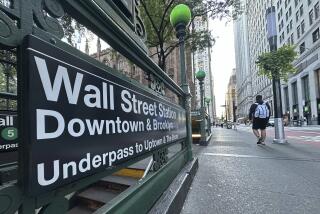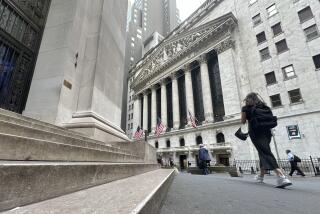‘No’ vote could hit you in your 401(k)
The anti-bailout crowd got what it wanted Monday: More pain for Wall Street fat cats, to the tune of the biggest one-day drop in key stock indexes since the 1987 market crash.
Unfortunately, that pain also was felt in the not-so-fat 401(k) retirement savings plans of millions of Americans.
The 777-point, 7% plunge in the Dow Jones industrial average, fueled in large part by the U.S. House’s “no” vote on the White House’s $700-billion financial-system rescue, points up the dilemma for many of those who oppose the measure as a handout to Wall Street.
Nobody really wants to help the investment and commercial bankers who dug their own graves by lending recklessly during the housing bubble.
But amid deepening gloom about the financial system and the economy, rooting for the banks’ demise now risks more days like Monday -- when many people saw the value of their stock holdings fall by near double-digit percentages in a mere 6 1/2 hours of trading.
That’s going to hurt the average worker with money in the market far more than it will hurt a bank executive with millions of dollars to spare and a generous pension to boot.
On Monday, the selling was so fierce that only a relative handful of stocks rose. And many companies that have nothing to do with banking were hammered.
Shares of Google Inc. plummeted 12% to $381, a two-year low. U.S. Steel Corp. tumbled 17%. Energy giant Chevron Corp. slumped 11%.
I can only imagine that some people who oppose the bailout are smelling a conspiracy. After all, the more damage stock prices suffer, the greater the pressure on the House to come back and approve the administration’s proposal or some version of it that achieves the same end: using public money to buy up toxic mortgages from lenders and investors.
On CNBC early Monday, with the Dow already down about 500 points, one commentator said the “worst thing that could happen” would be for the market to rally back by the closing bell and lose only a couple of hundred points for the session.
That, he said, would suggest to House members who voted against the plan that the market could live without it after all.
Blackmail by Wall Street?
More likely, what’s happening with stocks is mirroring what has been happening in the banking system for the last few weeks, as frightened lenders, brokerages and other financial institutions increasingly hoarded cash rather than put the money into the economy in the form of a loan or an investment.
“There’s a lot of cash out there,” said Jerry Webman, senior investment officer at money management firm OppenheimerFunds in New York. “The problem is that no one has the confidence to commit it to an investment.”
Proponents’ argument for the bailout is that toxic mortgage debt is such a huge weight on the financial system that lenders can’t begin to function normally again unless the government helps to clear some of the loans away.
That’s the technical aspect of the bailout. Perhaps just as important, the plan’s supporters say, is the psychological boost that a government rescue could give to lenders and investors who now fear a downward spiral as credit stops flowing to the economy because of the iced-over banking system.
The shutdown of credit, in turn, could lead to more loan defaults, more layoffs, less spending and a shrinking economy, all of which could make people with money even less willing to put it into the financial system for fear of loss.
“The spiral needs to be broken by a dramatic infusion of confidence,” said Quincy Krosby, chief investment strategist at Hartford Financial Services Group.
And Wall Street’s view is that there is only one entity big enough to accomplish that: Uncle Sam.
Over the last year, although stock prices overall have fallen, the market’s losses have been a sideshow to the debacle in the credit markets. Panic selling in stocks had been concentrated in the financial sector, as the list of collapsed banks and brokerages lengthened.
But with Monday’s historic dive, the stock market now is reflecting a level of fear among investors that, by some measures, is greater even than what gripped them after the Sept. 11 terrorist attacks.
What’s more, the extent of the market’s decline from last year’s record highs has reached a threshold of pain that will challenge many buy-and-hold individual investors.
With Monday’s drop, the Standard & Poor’s 500 index -- a benchmark for many buy-and-hold portfolios -- is down 29% from the all-time high reached last Oct. 9.
That is still within the limits of the average “bear market” loss of 34% since 1937. In other words, the S&P; index could fall an additional 5% or so before bottoming, and the peak-to-trough decline would be no worse than the typical such slide in times of economic turmoil.
But the last bear market was far worse than average. From 2000 to 2002, amid the collapse of the dot-com bubble, the S&P; plunged 49%, the biggest drop since the latter years of the Great Depression.
With many broad market indexes now down 30% or so from their highs last year, the question is whether small investors who regretted riding out the 2000-02 stock decline will decide they don’t want to risk those kinds of losses again -- particularly as the dire straits of the financial system evoke frightening images of the 1930s.
“There’s no reason to say we can’t have two mega-meltdowns in the same decade,” concedes Sam Stovall, investment strategist at Standard & Poor’s in New York.
People who oppose the bailout plan, and who want financial companies to pay for their sins in the housing debacle, may believe they won a great victory Monday.
The question is, will it still be a victory a week from now if the stock market is 25% lower, the economy is skidding into a deep recession, and Main Street, like Wall Street, finds credit nowhere to be had?
--
More to Read
Inside the business of entertainment
The Wide Shot brings you news, analysis and insights on everything from streaming wars to production — and what it all means for the future.
You may occasionally receive promotional content from the Los Angeles Times.










